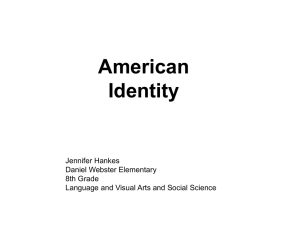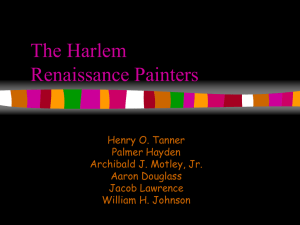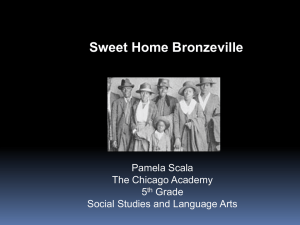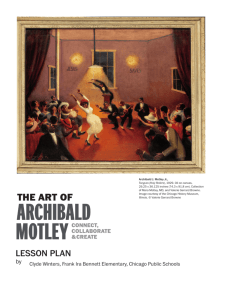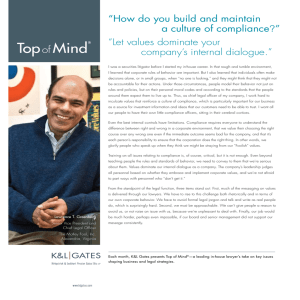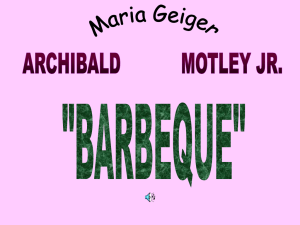Document 14343442
advertisement
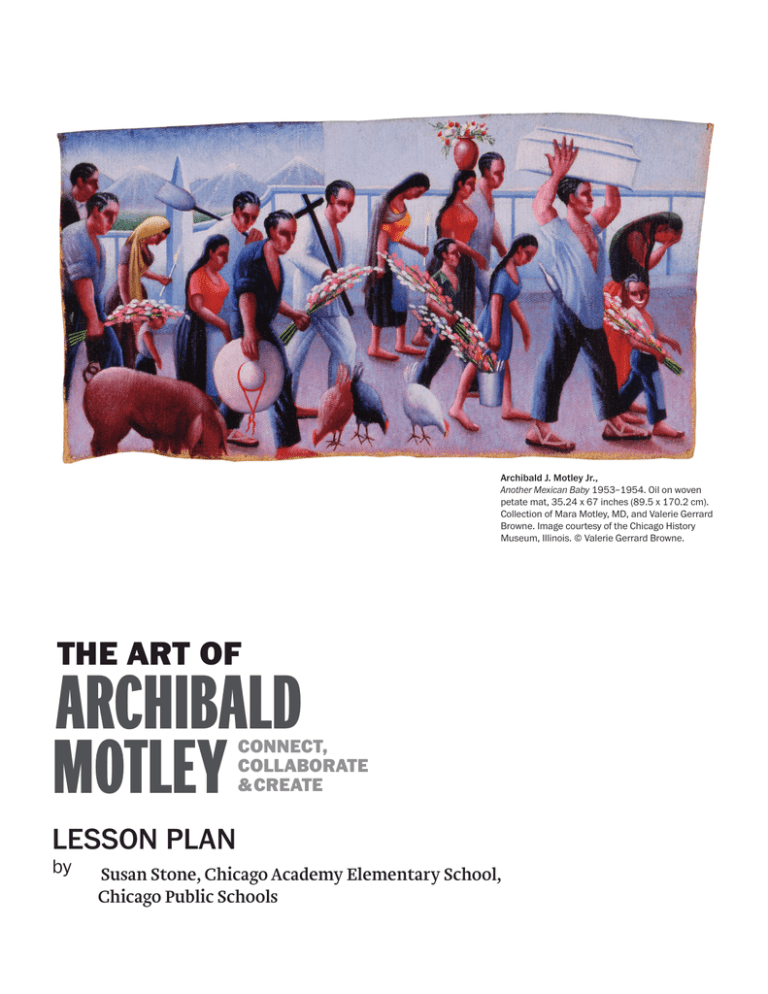
Archibald J. Motley Jr., Another Mexican Baby 1953–1954. Oil on woven petate mat, 35.24 x 67 inches (89.5 x 170.2 cm). Collection of Mara Motley, MD, and Valerie Gerrard Browne. Image courtesy of the Chicago History Museum, Illinois. © Valerie Gerrard Browne. THE ART OF ARCHIBALD MOTLEY CONNECT, COLLABORATE & CREATE: LESSON PLAN by Susan Stone, Chicago Academy Elementary School, Chicago Public Schools Summary of lesson plan This unit, “Push and Pull: Migration Tug-o-War” for 5th grade language arts and social studies explores the themes of migration, movement and change in connection with Archibald Motley’s painting, Another Mexican Baby (1953-54). It examines the opportunities and obstacles that migrants face; specifically contradictions that migrants experience. The students will view art, read a text about migration, write migration stories and create art around their experiences. Big Idea • People migrate for a variety of reasons with a variety of results. • Paintings can tell a story. • Everyday experiences hold significance for the people involved and for those who document them. • Migration experiences are motivated by both necessity and choice (push and pull factors). • Themes can be expressed in a variety of ways based on the medium in which they are created. Enduring Questions • How do events and experiences influence people to move and change? • How do migration experiences create opportunities for some and obstacles for others? • How do artists and writers express these experiences? Learning Objectives • Identify reasons for migration. • Analyze a painting to determine theme and message. • Analyze how the artist conveys that theme. • Compare and contrast works of art. • Describe how migration is both universal and personal. • Describe how migration experiences create both obstacles and opportunities. Standard Common Core Standard Objectives – Students will. . . RL.5.3 Compare and contrast two or more characters, settings or events in a story or drama drawing on specific details in the text (how characters interact). Read Esperanza Rising by Pam Muñoz (NY: Scholastic 2000. They will identify challenges that Esperanza faces throughout the novel. RL.5.7 RL.5.8 5.RIT.7 5.W.3 5.W.4 5.SL.1 CCR- analyze how and why individuals, events and ideas develop and interact over the course of a text. Analyze how visual and multimedia elements contribute to the meaning, tone or beauty of a text. Students will analyze how Esperanza’s interactions with the other characters cause changes for her. Students will analyze Archibald Motley’s painting Another Mexican Baby to identify elements that contribute to tone and mood. CCR- Integrate and evaluate content presented in diverse media and formats including visually and quantitatively, as well as in words. Compare and contrast stories in the same genre Students will comparing the painting to the art and on their approaches to similar themes and topstories in Carmen Lomos Garza’s book Family Picics. tures/ Family Pictures Cuadros de Familia (1990). CCR- Analyze how two or more texts address similar themes or topics in order to build knowledge or to compare the approaches the author’s take. Draw on information from multiple print or digital sources demonstrating the ability to locate an answer to a question quickly or to solve a problem efficiently. Students will determine important events in the life of Motley using the online timeline organized by the Nasher Museum of Art at http://nasher.duke.edu/motley/ CCR Integrate and evaluate content presented in diverse media and formats, including visually and quantitatively, as well as in words. Write narratives to develop real or imagined experiences or events using effective technique, descriptive details, and clear event sequences. Produce clear and coherent writing in which the development and organization are appropriate to task, purpose and audience. Students will create a “Postcard Project,” writing narratives on migration experiences inspired by the painting and texts. Students will write descriptive passages about a place where they hope to visit in the style of a travel brochure. Engage effectively in a range of collaborative dis- Throughout the project, we will have whole class, cussions (one on one, in groups and teacher-led) partner and small group discussions. with diverse partners on grade 5 topics and texts, building on others’ ideas and expressing their own clearly. Lesson Plan Activities Length: This lesson has several sessions that take place over a 3 week period. Develop questions about the characters during reading and identify cause and effect relationships. As a culminating activity connected with this book, have the students write postcards between the main character and her grandmother describing their experiences (Rubric attached). members don’t necessarily have to have migrated from another country. Migrations are movements and they can take Materials/Supplies for the Lesson: place within the country, state or even parts of the city. Students can conduct • Reading notebooks interviews in person, online or over the • Writing and drawing materials phone. A helpful planning sheet can • Woven mat or placemat be found at: http://web.archive.org/ The postcard project connects to Motley by web/20080905154756/http:www.ma• Paints and brushes showing communication between people calester.edu/geography/mage/teachers/ Day 1: Close read of the painting. Students in Mexico and the United States. An addi- archives/2002nclb/hedenstrom/Migralook at Motley’s painting, Another Mexitional written reader response activity can tionSeriesPlanSht.htm can Baby (1953-54) for about 5 minutes be connected to either theme/message or completing the “I notice… This makes me how the main character changes from the Day 11-13: Write migration story. Utilize think…” T-chart. Whole class discussion beginning of the story to the end. the writing process. follows. Allow students to share insights. Here are some suggested questions and Day 3: Read Carmen Lomas Garza, Family Day 14-15 Create a travel brochure for the prompts to use as needed to guide the Pictures/ Family Pictures Cuadros de Famil- place your family migrated from to come discussion. ia. (Children’s Book Press. San Francisco, to Chicago. Include elements that would CA, 1990). Compare/Contrast these images showcase the site and entice people to • What do you see? What else do you see? of daily life in Mexico to Motley’s painttravel there. (Stick to observations only at first). ing, Another Mexican Baby. Focus quesDay 16: Create a scene from your own famtion: How are these images like Motley’s • What’s happening in this picture? painting? How are they different? Why do ily migration story and paint it on woven • What did you notice first when you you think Motley and Carmen Lomas Garza mat fabric. (Could use placemats, sourced looked at this picture? Why do you think at Dollar Tree). created pictures like these? your eye traveled there first? Day 17-18: Share out stories, brochures Day 4: Using Family Pictures as a model, • What is the mood of this picture? What write a narrative describing Another Mexi- and artwork in a culminating event. makes you think that? How did the artist can Baby. Assessments: create this mood? Day 5: Read and discuss article about Motley’s exhibit at the Library. Why would this generate so much interest? (Market Scene Comes to Chicago: NEGRO ARTIST EXHIBITS • Where do you think this painting is taking AT PUBLIC LIBRARY Chicago Daily Tribune (1923-1963); Oct 25, 1953; ProQuest place? Historical Newspapers: Chicago Tribune • Why do you think the artist painted this (1849-1989) pg. S_A2). picture? What message is he trying to convey? Days 6 and 7: Build background knowledge of Motley through on-line readings. • What title would you give this painting? Emphasize the idea of choice migration Now that you know the title, does your and that Motley traveled to Mexico to visit idea of the message change? Why or why his nephew. (Nasher Museum of Art, Duke not? University, Archibald Motley: Jazz Mod• What would you like to know about the ernist timeline, artworks and audio guides: http://nasher.duke.edu/motley/#timeline) artist? • Pick a person in the painting – What would that person say? What makes you think that? (D) Diagnostic The students will complete a t-chart with the headings “I Notice…” and “This Makes Me Think…” for the initial viewing of the painting. (F) Formative – the check for understanding mechanisms used throughout the unit to ensure each student gets the instruction needed to be successful on the summative performance assessment. Examples: reader’s notebooks, post-it jots, small group anecdotal records, discussion, drafts. The students will complete “do now slips” for the beginning of lessons and “exit tickets” throughout the unit. Reader’s • How would you describe this artwork to Day 8: Examine the brochures about travel notebook entries connected to the text will someone else? to Mexico at that time period. What infor- also be assessed. Venn diagrams will be mation can we learn about the time period used to compare the art in the text Family • How does this artwork relate to our study and the place from these brochures? Pictures to Motley’s painting, Another of migration? Mexican Baby. The following activities are part of a larger Teachers can find examples on-line, unit that would follow. The pacing guide is especially at sites such as Pinterest, using (S) Summative – the “summary of student’s achievement in relation to…learning search terms “Mexican Travel Brochures suggested. 1930s-50s”— https://www.pinterest.com, standards.” Day 2: Class discussion of migration –what additionally, see appendix for one example. Postcard Project, The written account of are the reasons, motivations, etc. Encourfamily migration, travel brochure, narraDay 9: Generate list of questions one might age students to consider multiple perspective about the artwork and creating the use to interview a relative about their tives. Introduce the idea of push and pull artwork. Photographs, student written migration story. Review protocol for interfactors in regard to migration. work including exit tickets and a formal viewing someone. written migration story, artwork created Ongoing: Read novel Esperanza Rising by Day 10: Students will interview family by students including postcards, a travel Pam Muñoz (NY: Scholastic 2000). members or friends regarding migration brochure, and narrative about the painting. story. Remind students that their family Works of Art Archibald J. Motley Jr., Another Mexican Baby, 1953–1954. Oil on woven petate mat, 35.24 x 67 inches (89.5 x 170.2 cm). Collection of Mara Motley, MD, and Valerie Gerrard Browne. Key information about the artist: Motley grew up in Chicago and attended the School of the Art Institute. He is well known for his portraiture and scenes depicting life in Chicago’s vibrant Bronzeville neighborhood in the 30’s. Motley had always seen himself as a painter of people and this painting reflects that. The painter visited his nephew, Willard Motley frequently after he moved to Guanajuato, Mexico in 1951. Archibald and Willard (a writer) were attracted to the everyday events in people’s lives and visited many towns and tourist sites including Cuernavaca, Puerto Vallarta, San Blas, San Miguel, and Toluca. Key information about the artist’s context: This painting was created during Motley’s visits to his nephew, Willard, in Mexico. At this time, Mexico was generating great interest in both business and travel and tourism. The economy was booming, but the existing class hierarchy kept the poor from benefiting from this boom. Key information about the work of art: The artwork was painted on woven petate mat. These mats were commonly used for sitting or sleeping on in Mexico by the working class. The scene of the funeral procession is created with the characters all facing the same direction, drooping shoulders and carrying various materials associated with the act of burying the dead. The image portrays infant mortality among the poor, which was high due to existing class systems and lack of medical care for the poor. List of resources for teachers: The Nasher Museum of Art, Archibald Motley: Jazz Age Modernist. Nasher Museum of Art, Duke University, Durham, NC, 9 Feb. 2015. < http://nasher.duke.edu/motley/#timeline > Powell, Richard J. Archibald Motley Jazz Age Modernist. Nasher Museum of Art, Duke University. Durham, NC: Duke University Press (2014). “Negro Artist Exhibits at Public Library” Chicago Daily Tribune. October 25, 1953. Proquest Historical Newspapers: Chicago Tribune (1849-1989). Pg S_A2. List of resources for students: • Garza, Carmen Lomas. Family Pictures/ Cuadros de Familia. Children’s Book Press. San Francisco, CA (1990). • Ryan, Pam Muñoz. Esperanza Rising. Scholastic. New York, New York (2000). Acknowledgments: This lesson plan is the result of a series of professional teacher development workshops initiated by hosted by Columbia College Chicago and Chicago’s Department of Cultural Affairs and Special Events for the exhibition Archibald Motley: Jazz Age Modernist. The exhibition was organized by the Nasher Museum of Art at Duke University. Grant support to the Chicago Department of Cultural Affairs and Special Events provided by the Nasher Museum of Art at Duke University and the Terra Foundation for American Art. Support to the Nasher Museum of Art at Duke University provided by the Terra Foundation for American Art; the National Endowment for the Humanities: Exploring the human endeavor; and the Henry Luce Foundation; and the Wyeth Foundation for American Art. The educational collaboration was facilitated through Columbia’s Department of Education, Art + Design, the Center for Community Arts Partnership and the Dean’s Office for the School of Fine and Performing Arts. Additional support and planning was contributed by Chicago Public Schools, Chicago Public Library, Carter Woodson Branch and the Chicago Metro History Project. Contributing individuals for the Chicago initiative include: Anne Becker, Beverly Cook, Susan Friehl, Michael Flug, Lynne Green, Amy Mooney, Cecil McDonald, Jr., Sadira Muhammad, Lisa Oppenheim, Daniel Schulman, Jennifer Siegenthaler, and Ray Yang. Appendix This example of a 1930s travel brochure was created by Oakland’s Central Travel Agency and was posted on-line by Adrian Yekkes, 2 Feb. 2014, http://adrianyekkes.blogspot.com/2014_02_01_archive.html
